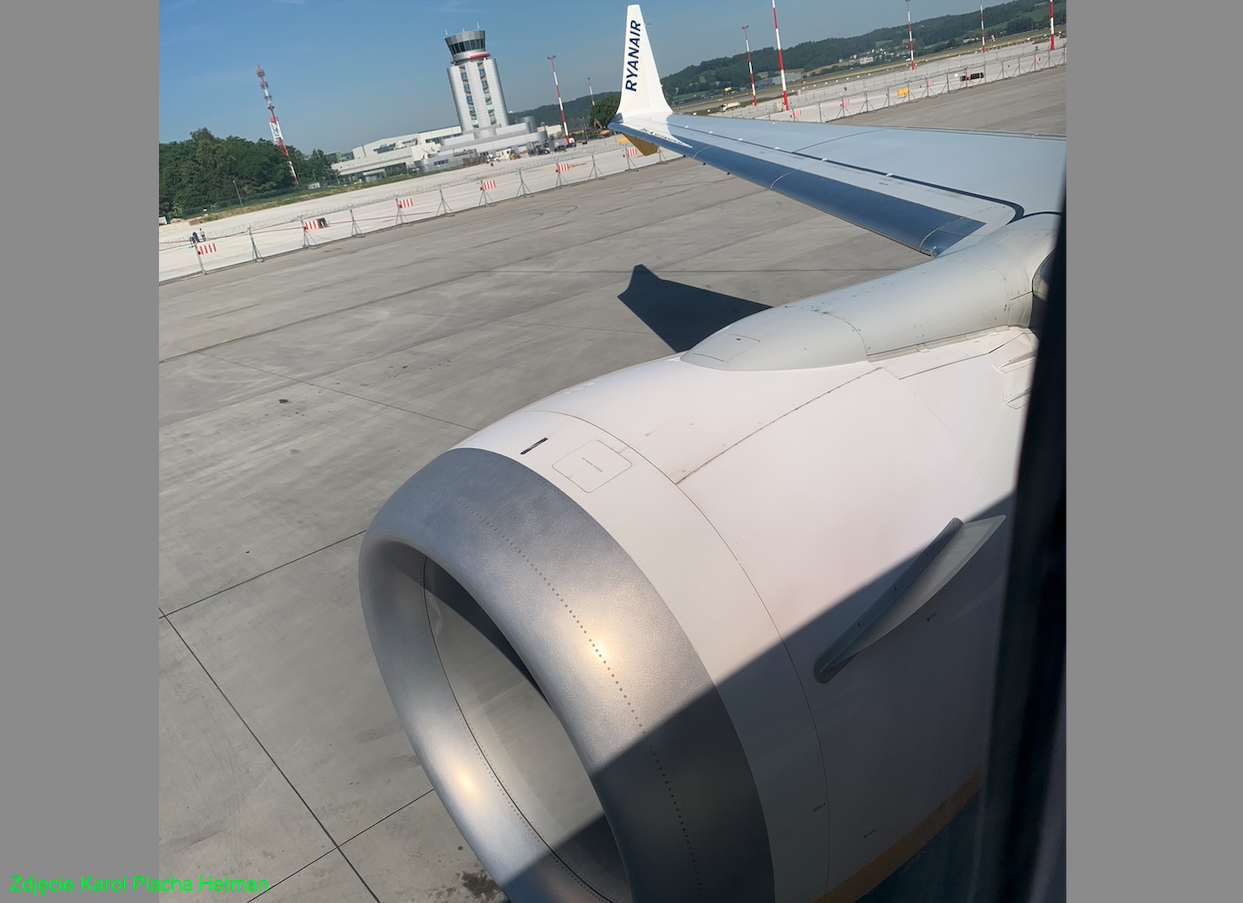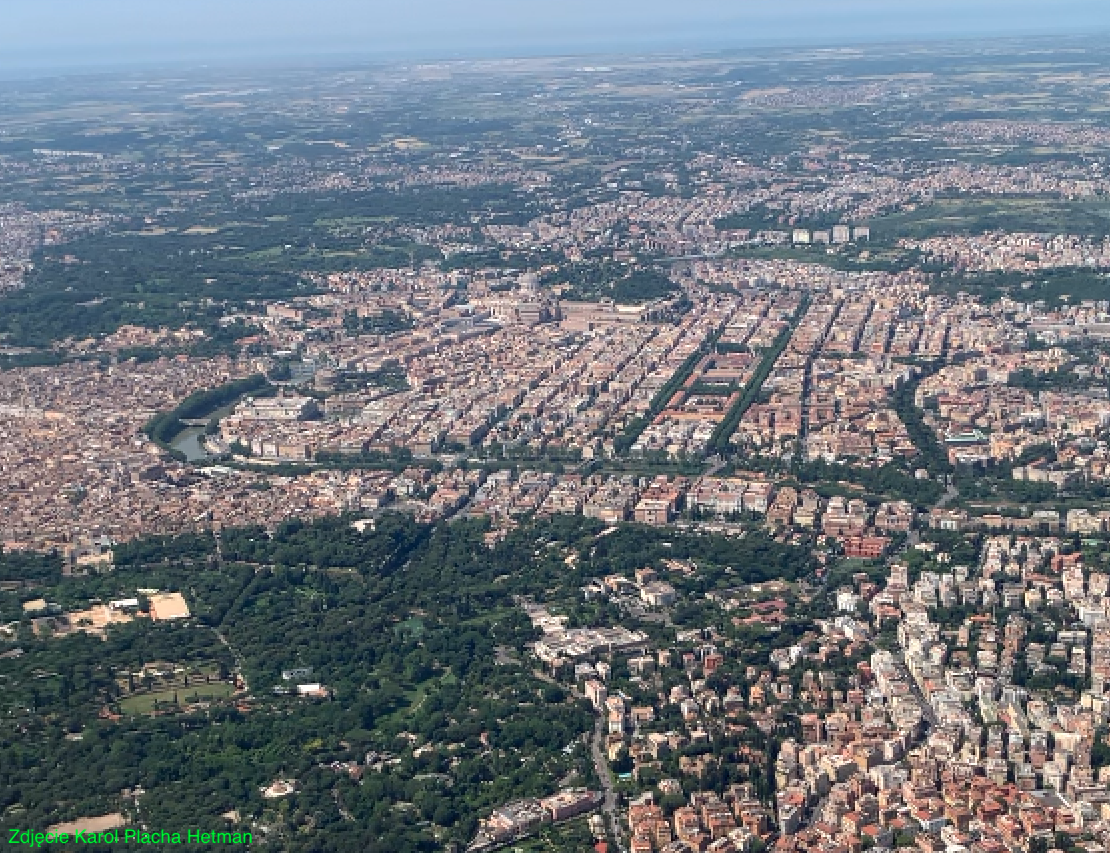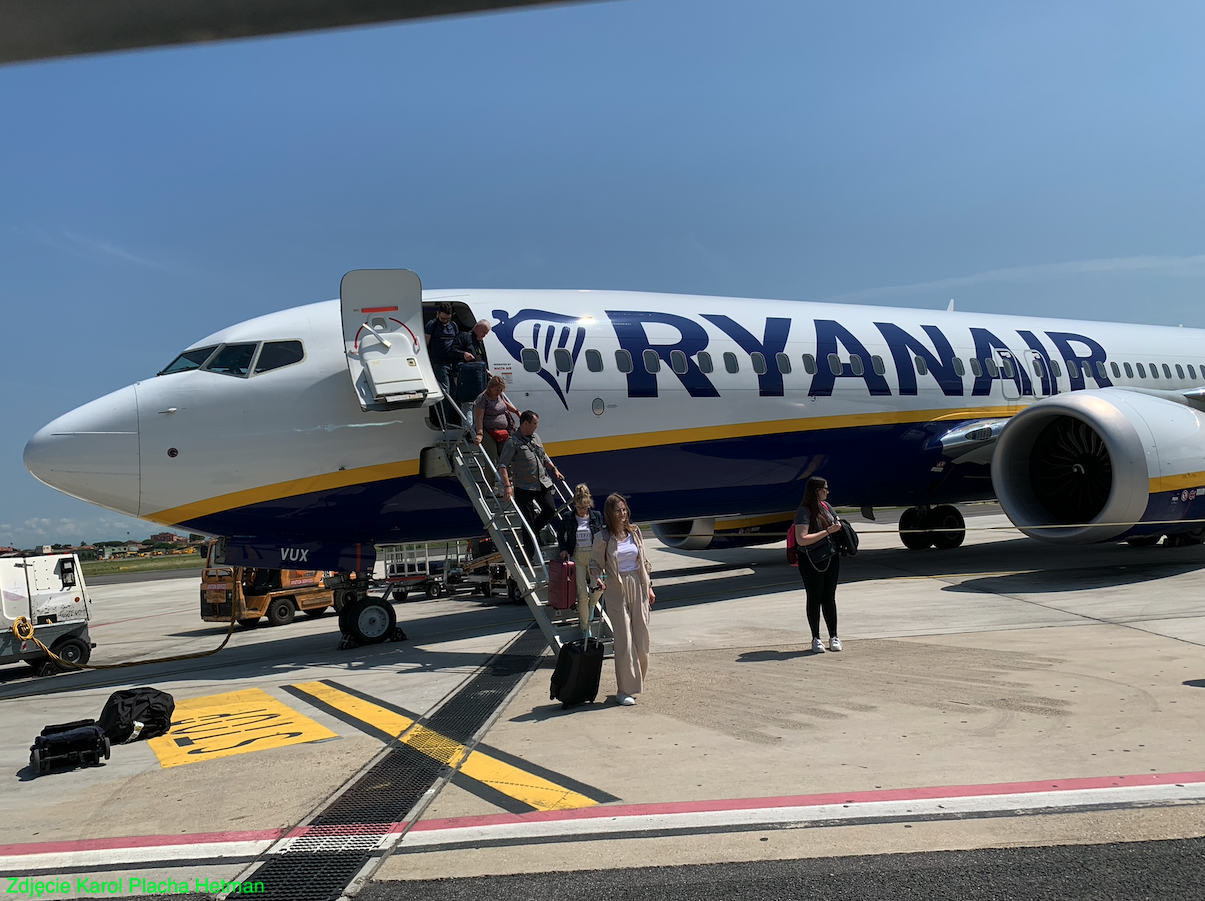Kraków 2023-06-10
Flight from Krakow to Rome. 2023.
The Irish airline Ryanair, headquartered in Dublin, was founded by the Ryan family in 1985. Already in 2010, the carrier offered about 1,500 flights a day to 54 airports in 27 countries in Europe and the Mediterranean basin. In 2012, the airline carried around 78 million passengers. The carrier is also present in Poland and in 2010, it offered flights from Polish cities: Warsaw, Łódź, Kraków, Katowice, Rzeszów. At that time, the carrier offered flights mainly with Boeing B.737-800 aircraft.




Boeing B-737 MAX program.
The Boeing B.737 MAX aircraft is another modernized, fourth variant of the iconic Boeing B.737 liner aircraft. The previous series were Boeing B.737 NG (Next Generation) aircraft. Among them, the most popular were the Boeing B.737-800, the production of which ended in 2020.
What distinguishes the B.737 MAX 8 from the B.737 NG variants is the new winglets at the wingtips. They resemble the wings of birds that can travel thousands of kilometers. The new winglets have a lower weight than the previous ones.
The main change in the B.737 MAX 8, however, are the engines. These are the engines of the same family that has been used for years, but they allow for 15% lower fuel consumption compared to the B.737-800 NG model. The motors emit 40% less noise. They have lower CO2 emissions in exhaust gases.
For passengers, the cabin received a new decor. Boeing offers several seat upholstery patterns. The lighting in the cabin is also modeled on the B.787 aircraft, i.e. based on LED technology. The windows in the passenger cabin are slightly larger and placed slightly higher, which makes it easier to observe the ground and sky. Luggage compartments above the passengers' heads have been arranged differently. They are slightly larger and drop down when opened. However, they require more force to lift and close them. In the B.737-800, all you need to do is close the door. Polish planes in PLL LOT B.737 MAX 8 are in a typical one-class layout and have 186 seats. There was a proposal that the rear passenger door should be equipped with its own automatic staircase, just like the front door. But it would require a complete rebuild of the rear fuselage section.
Minor changes have been made to the crew cockpit. Rockwell Collins supplies four 15.1-inch (380 mm) liquid crystal displays (LCDs) that are also used in the Dreamliner B.787 aircraft. This improves pilots' awareness of the flight situation. In addition, Boeing did not want to make significant changes, so that the control of the aircraft was consistent with the B.737 NG aircraft.
The B.737 MAX aircraft program was launched on August 30, 2011. The Boeing B.737 MAX prototype made its first flight on January 29, 2016. The FAI certificate was granted on March 9, 2017. Deliveries to users began in May 2017. List price was $90-125 million. The aircraft is offered in four lengths; B.737 MAX 7, MAX 8 and MAX 9, replacing the 737-700, -800 and -900, and then the extended MAX 10. The aircraft usually offer 138 to 230 seats. The B.737 MAX 10 offers up to 230 passenger seats. The aircraft offer a range of 5,954 km to 7,084 km (3,215 NM - 3,825 NM). Since the announcement of the program, the aircraft has been ordered in a staggering amount of 3,954 (2011-2017). In 2017, the Boeing Company announced that it would increase the production rate of B.737 models from 42 units per month to 57 units per month.
The main reason for undertaking the program was the development of new turbofan engines; CFM International LEAP and Pratt & Whitney PW-1000G. These engines are more economical, quieter and emit less exhaust fumes. A similar decision was made by Airbus, launching the Airbus A.320neo program. In 2011, Airbus already had 667 orders for new aircraft. In mid-2011, American Airlines announced an order for 360 aircraft, including 260 Airbus A.320s and possibly 100 B.737NGs, with CFM LEAP engines. The privilege clauses functioning on the US market forced the Boeing Company to develop a new model. On August 30, 2011, the board of directors of the Boeing Company approved the B.737 MAX program. The basic model was to be 4% more economical in operating costs than the new Airbus A.320neo.
The company abandoned the development of a completely new airframe. Only specific areas of the airframe were modified. Aerodynamic research went first. The shape of the tail cone was modified so that its flow was laminar. Cone lengthened 46 inches. The profile of the vertical tail was also modified. The front part of the fuselage was extended by 30 inches. New winglets were also developed, which became the distinguishing feature of the aircraft. Modification costs amounted to only 10-15% of what would have to be spent on the development of a new aircraft. By the way, the CEO of the Boeing Company, Jim McNerney, revealed that a completely new aircraft will probably be built in 2030 and will be composite. Presumably, it will be larger and will take up to 250 passengers.
The B.737 MAX aircraft has 14% less fuel consumption than the B.737 NG. On August 13, 2015, the first fuselage of the B.737 MAX was assembled at Spirit Aerosystems in Wichita, Kansas. The aircraft rolled out of the production hall in Renton on December 8, 2015. Four B.737 MAX 8 aircraft with numbers 1A001, 1A002, 1A003, 1A004 were used in the tests. The tests covered 2,000 flight hours.
CFM International LEAP engine.
The CFM56-7B engine was modified. Fan changed. It has 18 carbon fiber blades instead of 24 titanium blades. It has a greater external flow; 9:1 instead of 5:1. It emits 40% less noise. The fan is 68 inches (173 cm) in diameter, up from 66 inches (168 cm) previously. After minor modifications, the distance of the engine nacelle from the ground was kept at 0.43 m (17 in). It is important to know that the Airbus A.320neo has a 2.00 m (78 in) fan. In 2013, Boeing opted for an even larger 176 cm (69.4 in) fan, because the designers extended the aircraft's front landing gear leg by 8 inches (20 cm).
The engine is two-shaft. The low pressure shaft has a fan and 3-stage compression and a 3-stage turbine. The high pressure shaft has 10 compressor stages and 2 turbine stages. The overall compression ratio is 41:1 versus 28:1 previously. The engine has a higher exhaust gas temperature in front of the turbine than before. The engine has 15% lower powertrain fuel consumption (TSFC), 20% lower carbon dioxide emissions, 50% lower nitrogen oxide emissions. The new engines allowed the B.737 MAX 8 aircraft to have a cruising ceiling of up to 12,000 m.
MAX aircraft versions.
B.737 MAX 7 - The smallest of the family. Equivalent to B.737-700. As standard, it is designed for up to 138 passengers. Max range 7,130 km (3,915 NM). About 300 were ordered, but the prolonged certification of the machine resulted in the withdrawal of several operators.
B.737 MAX 8 - Basic version. Equivalent to B.737-800. Range 6,510 km (3,515 NM). Cruising speed 0.78 Ma.
B.737 MAX 200 - a variant of the B.737 MAX 8 for 200 passengers, with very dense seats.
B.737 8ERX - Version that combines the wings and landing gear from the MAX 9 with the fuselage of the MAX 8, for 150 passengers. The goal is a range of 7,400 km (4,000 NM), so flights across the Atlantic are possible.
B.737 MAX 9 - This is a model that replaces the B.737-900. The certification took place in the spring of 2018.
B.737 MAX 10 - Because the B.737 MAX 9 won few orders, the Boeing Company proposed an aircraft with a larger wing and more powerful engines. In a single-class layout, the plane is to take 226-232 passengers. Planned range 6,100 km (3,300 NM). The problem is that CFM LEAP-1B engines, with a thrust of 140 kN, were available in 2020, which is why the program was delayed. According to the manufacturer, the Boeing B.737 MAX 10 is to be the cheapest in terms of costs, per passenger seat, in a narrow-body aircraft. The B.737 MAX 10 aircraft was waiting for certification, which is expected for the winter of 2023 - 2024. The first deliveries are expected in spring 2024.
BBJ MAX 8 and BBJ MAX 9 - are planned versions of business jets, with a range of 11,714 km (6,325 NM) and 13,000 km (7,000 NM) respectively.
Ryanair company.
Two crashes of B.737 MAX 8 aircraft (in Ethiopia and Indonesia), followed by the Chinese virus pandemic, slowed down the Boeing 737-MAX program, but did not interrupt it. In 2020, Ryanair, assuming that - "Every war ends someday" - started negotiations on the purchase of a large batch of B-737-MAX-8 aircraft. 135 aircraft were ordered, and then another 75 copies were ordered. As Boeing later commented, "at a ridiculously low price." B.737 MAX 8 aircraft are called B.737-8200 by carriers. The planes are configured with 197 passenger seats.
Subsequently, Ryanair started talks on the purchase of B-737-MAX-10 aircraft. But these talks were already very difficult and after 18 months Ryanair withdrew from the negotiations. Ryanair boss Michal O'Leary said Boeing had charged too high a price for the new planes. But after a few months, negotiations were resumed. On May 9, 2023, a contract was concluded for the purchase of 150 B.737 MAX 10 aircraft, with an option for another 150 aircraft. The value of the contract is USD 40 billion. Ryanair refers to the B.737 MAX 10 as a 'Gamechanger' as the company considers the aircraft to be the most economical single-aisle aircraft. Ryanair is one of Boeing's largest and most important customers. The planes are configured with 228 passenger seats.
It is known that since 2020, the supply chain of components from manufacturers has been disrupted. The reason was the Chinese virus pandemic. But Boeing's main competitor, Airbus, also had serious production problems. The Ryanair group includes the Maltese company Lauda Europe, which considered buying A.320neo and A.321neo aircraft. The contract for 150 B.737 MAX 10 aircraft has thwarted plans to purchase Airbus aircraft.
Currently (2023) the fleet of Ryanair Holdings Group (consists of: Ryanair, Lauda Europe, Malta Air, Ryanair UK, Ryanair Sun, Buzz) has 542 aircraft: 29 Airbus A.320, 410 B.737-800 aircraft and 103 B aircraft .737 MAX 8200. The carrier was waiting for deliveries of MAX aircraft: 107 B.737 MAX 8200 aircraft (delivery completion in 2024) and 150 B.737 MAX 10 aircraft.
Flight KRK - CIA. June 1, 2023.
In 2023, Ryanair had approximately 107 B.737 MAX 8 aircraft (8,200). That is why they can be found more and more often at airports in Poland. B.737 MAX 8 aircraft, registration 9H-VUX, serial number 62337, type 737-8MAX 200. It made its first flight on February 14, 2022, with registration N4022T. It is powered by two CFMI LEAP-1B engines. It was built at the Renton (RNT) factory. There are 197 seats in the cabin. One-class layout.
On June 1, 2023, the aircraft made 5 flights. At 09:42, the plane took off from KRK airport on schedule, to land at CIA airport at 11:17. The plane took off from RWY in Krakow towards the west. Gaining altitude, he took a southerly course towards Zagreb. In the middle of the flight, the plane was flying at a speed of 833 km/h (ground speed 826 km/h, speed 0.788 Ma). Course 208 degrees. Relative altitude 11,582 m. GPS altitude 11,819 m. Outside temperature -58 degrees Celsius. The landing approach was at the CIA's heading 15, overlooking Rome to the right. Landing time 11:17.
Written by Karol Placha Hetman
